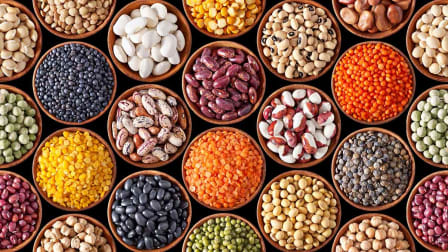5 Diabetes Diet Myths, Busted
Get the real deal on carbs, fruit, weight loss, and more

It's been known for years that a healthy diet is a cornerstone of diabetes care. So it’s no surprise that 65 percent of people with the disease say they revamped their eating style after their diagnosis, according to a recent CR survey of 2,911 American adults who have diabetes or prediabetes or live with someone who does.
But persistent myths—like “fruit’s now off the table” or “you can only eat sugar-free sweets”—make it tough to know what a healthy diet for prediabetes and diabetes looks like. “I find people are confused all the time, partly because of the many conflicting messages they receive,” says Elisabetta Politi, a dietitian and diabetes educator at Duke Health in Durham, N.C.
Making lifestyle changes that will help keep your blood glucose in check is also easier said than done, according to CR survey respondents: Half consider it difficult or very difficult, and some groups face bigger challenges than others. For instance, 39 percent of Blacks and Hispanics are hard-pressed to find the time and energy to prepare healthy meals, compared with 32 percent of whites. More than one-third of Hispanics also say finding healthy food is an issue, a similar concern for 22 percent of whites and 25 percent of Blacks.

Truth
In general, “the biggest driver of blood sugar is how much carbohydrate you’re eating, so cutting back on starches and sugars is probably the best way to help control blood sugar,” says William Yancy, MD, associate professor of medicine at Duke University School of Medicine in Durham, N.C.
But that doesn’t mean avoiding carbs altogether. Limit refined carbs, such as foods with added sugars and white flour. Many have a high glycemic index (GI), which means they can cause blood sugar spikes. Studies show that replacing high-GI carbs with low-GI items can improve blood sugar control. In fact, low-GI, unrefined carbs, such as legumes, whole grains, and vegetables, are terrific choices for people with diabetes, and they may lower the risk for type 2 diabetes in the first place.
It’s also okay to have cake, a cookie, or ice cream once in a while, even though they contain sugar. Sugar-free treats are an option but may be higher in carbs than the foods they’re intended to replace, so they could raise blood sugar—especially if you think “sugar free” means it’s okay to eat more, says dietitian Kim Pierce, a diabetes educator at the Cleveland Clinic.

Truth
There’s no one-size-fits-all plan. A 2019 American Diabetes Association consensus report reviewed eight diets—including low-carb, low-fat, Mediterranean, and paleo—and found that they all can help people prevent or manage diabetes. It turns out a good diabetes diet is simply one with a variety of nutrient-rich whole foods, realistic portions, and limited processed foods. Keep those guidelines in mind and you can eat right and still accommodate your personal preferences and traditions (even an occasional pizza night).

Truth
It depends. “Diabetes” foods, such as shakes and bars marketed to keep blood sugar steady, can help in the short term because they’re nutritionally balanced and portion-controlled, Politi says. But they’re certainly not a necessary part of your diet. And these products are often highly processed, so if you consume them, keep it to a minimum.

Truth
Not necessarily. Dropping just 5 percent of your weight improves blood sugar, Yancy says, especially if you’re also exercising and following a healthy diet. Losing more can confer bigger benefits: In a study of 867 people with type 2 diabetes, those who shed at least 10 percent of their weight in their first year were more than twice as likely to achieve normal blood sugar levels without medication within five years.

Truth
Feel free to enjoy an orange or a bowl of berries. The sugars in fruit may be chemically the same as added sugars in soda and candy, but they’re released slowly into the bloodstream, so they don’t cause rapid blood sugar increases. Fruit is also full of nutrients and may have diabetes-protective benefits. In a 2017 study, those who had fruit each day were 12 percent less likely to develop diabetes. For people who already had diabetes, eating fruit at least three times weekly cut the likelihood of diabetes complications, such as heart disease and vision problems, by 10 to 26 percent.
Editor’s Note: This article also appeared in the January 2021 issue of Consumer Reports magazine.




















